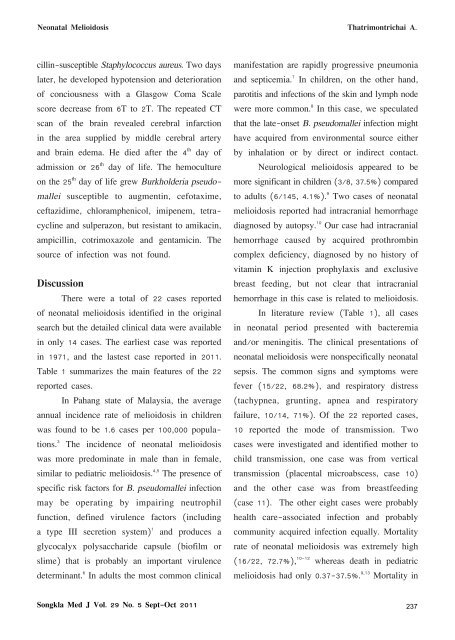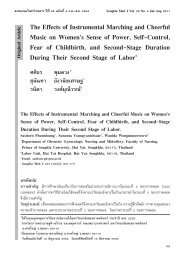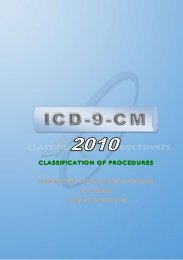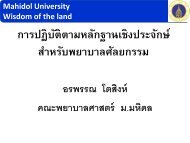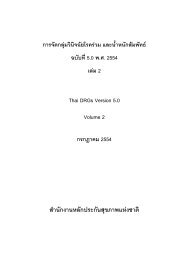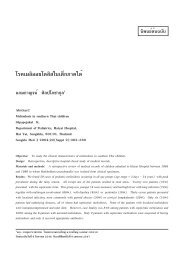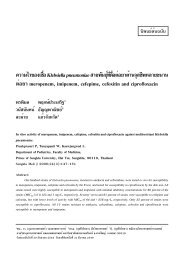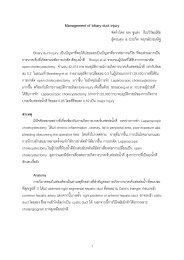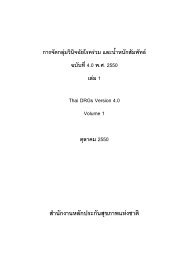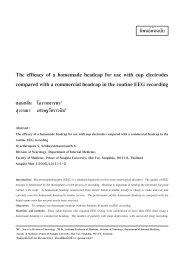A Case Report and Literature Review Anucha Thatrimontrichai ...
A Case Report and Literature Review Anucha Thatrimontrichai ...
A Case Report and Literature Review Anucha Thatrimontrichai ...
Create successful ePaper yourself
Turn your PDF publications into a flip-book with our unique Google optimized e-Paper software.
Neonatal Melioidosis <strong>Thatrimontrichai</strong> A.<br />
cillin-susceptible Staphylococcus aureus. Two days<br />
later, he developed hypotension <strong>and</strong> deterioration<br />
of conciousness with a Glasgow Coma Scale<br />
score decrease from 6T to 2T. The repeated CT<br />
scan of the brain revealed cerebral infarction<br />
in the area supplied by middle cerebral artery<br />
<strong>and</strong> brain edema. He died after the 4 th day of<br />
admission or 26 th day of life. The hemoculture<br />
on the 25 th day of life grew Burkholderia pseudomallei<br />
susceptible to augmentin, cefotaxime,<br />
ceftazidime, chloramphenicol, imipenem, tetracycline<br />
<strong>and</strong> sulperazon, but resistant to amikacin,<br />
ampicillin, cotrimoxazole <strong>and</strong> gentamicin. The<br />
source of infection was not found.<br />
Discussion<br />
There were a total of 22 cases reported<br />
of neonatal melioidosis identified in the original<br />
search but the detailed clinical data were available<br />
in only 14 cases. The earliest case was reported<br />
in 1971, <strong>and</strong> the lastest case reported in 2011.<br />
Table 1 summarizes the main features of the 22<br />
reported cases.<br />
In Pahang state of Malaysia, the average<br />
annual incidence rate of melioidosis in children<br />
was found to be 1.6 cases per 100,000 populations.<br />
3 The incidence of neonatal melioidosis<br />
was more predominate in male than in female,<br />
similar to pediatric melioidosis. 4,5 The presence of<br />
specific risk factors for B. pseudomallei infection<br />
may be operating by impairing neutrophil<br />
function, defined virulence factors (including<br />
a type III secretion system) 1 <strong>and</strong> produces a<br />
glycocalyx polysaccharide capsule (biofilm or<br />
slime) that is probably an important virulence<br />
determinant. 6 In adults the most common clinical<br />
manifestation are rapidly progressive pneumonia<br />
<strong>and</strong> septicemia. 7 In children, on the other h<strong>and</strong>,<br />
parotitis <strong>and</strong> infections of the skin <strong>and</strong> lymph node<br />
were more common. 8 In this case, we speculated<br />
that the late-onset B. pseudomallei infection might<br />
have acquired from environmental source either<br />
by inhalation or by direct or indirect contact.<br />
Neurological melioidosis appeared to be<br />
more significant in children (3/8, 37.5%) compared<br />
to adults (6/145, 4.1%). 9 Two cases of neonatal<br />
melioidosis reported had intracranial hemorrhage<br />
diagnosed by autopsy. 10 Our case had intracranial<br />
hemorrhage caused by acquired prothrombin<br />
complex deficiency, diagnosed by no history of<br />
vitamin K injection prophylaxis <strong>and</strong> exclusive<br />
breast feeding, but not clear that intracranial<br />
hemorrhage in this case is related to melioidosis.<br />
In literature review (Table 1), all cases<br />
in neonatal period presented with bacteremia<br />
<strong>and</strong>/or meningitis. The clinical presentations of<br />
neonatal melioidosis were nonspecifically neonatal<br />
sepsis. The common signs <strong>and</strong> symptoms were<br />
fever (15/22, 68.2%), <strong>and</strong> respiratory distress<br />
(tachypnea, grunting, apnea <strong>and</strong> respiratory<br />
failure, 10/14, 71%). Of the 22 reported cases,<br />
10 reported the mode of transmission. Two<br />
cases were investigated <strong>and</strong> identified mother to<br />
child transmission, one case was from vertical<br />
transmission (placental microabscess, case 10)<br />
<strong>and</strong> the other case was from breastfeeding<br />
(case 11). The other eight cases were probably<br />
health care-associated infection <strong>and</strong> probably<br />
community acquired infection equally. Mortality<br />
rate of neonatal melioidosis was extremely high<br />
(16/22, 72.7%), 10-12 whereas death in pediatric<br />
melioidosis had only 0.37-37.5%. 9,13 Mortality in<br />
Songkla Med J Vol. 29 No. 5 Sept-Oct 2011 237


